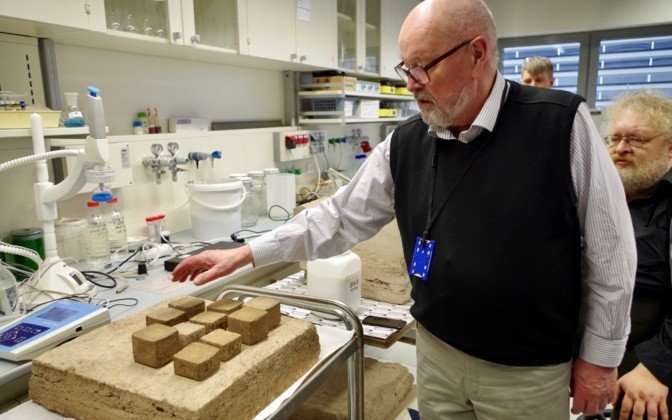Printing a house from a novel peat material

Scientists from the University of Tartu and the Estonian University of Life Sciences have created a construction material consisting primarily of peat and oil shale ash that could reduce the construction costs of a private house nearly tenfold. The aim was to create a self-supporting construction material based on local natural resources and waste that could be used to 3-D print houses up to two-storeys high directly at the construction site.
Wetlands cover about 22 percent of Estonia's area, but the peat growing there is not widely used. Only the drier top part of the peat layer has been deemed usable. The unused part is left to decay. This peat could also be used in an economically beneficial way. Many fractions can be separated from peat, for example humic substances and waxes, and the final residue can even be used for producing cellulose.
The most popular method for mining peat is milling. During milling, 10 to 20-mm layers are cut loose from the peat deposit and left to dry. For this method to pay off, most milling fields are larger than 100 hectares.
Raising the value of waste
"So far, no one has produced peat composite as a construction material because peat prevents many materials from hardening. In our project, we managed to overcome this issue," said Liiv. Instead of the usual cement, scientists from Tartu use oil shale ash as the binder in their mix. In Estonia, it is estimated that about 7 million tonnes of oil shale ash are created in a year, only 5 percent of which is reused. The rest is deposited in ash hills and this creates considerable environmental pollution.
Oil shale ash is classified as a hazardous waste because it becomes very basic when in contact with water (pH almost 13). However, ash with such a pH is the best fit for construction materials. The developed material is completely harmless and safe for the environment.
Furthermore, during testing, the scientists found a solution for reducing the setting time from about 30 days to one day. If the pH of a pore solution is below nine, it won't harden. This issue is solved by a very high pH by binding the potassium oxide and alkali metals found in oil shale ash to insoluble compounds.
Inside the peat, oil shale ash reacts with humic acids and absorbs carbon dioxide. Due to chemical reactions, the binder becomes regular concrete and limestone. According to Toomas Tenno, a professor at the University of Tartu's chair of colloidal and environmental chemistry, nanosized additives, e.g. nanosilica or silicon smoke, are added to peat and oil shale ash to improve their properties.
"As the particles are very small, they dissolve well and distribute throughout the material evenly. Silicon smoke improves the quality of this material significantly," said Tenno.
It took about a year before the right mixture was found for the material that is strong and has high thermal conductivity. After final hardening, the material is strong and very light, has low heat transfer and is durable. Even though peat is also used as fuel, the material developed by scientists is incombustible. The peat material achieves its initial hardness in 24 hours but remains elastic for a considerably longer time. Thus, there is no need for insulation or fillers and the entire structure becomes airtight without adding any wind protection. Furthermore, it is a good noise blocker.
As peat and oil shale ash are not very expensive, builders would be especially happy about the price of the material. According to Liiv, scientists calculated that the cost for the construction of a house shell printed from this material with a floor surface of 100-150 square meters could be about €5,000 (compared to the construction of the shell of a framed building of equivalent size, which would cost about ten times more).
By now, the research as well as many tests have been completed. Issues with materials technology have been resolved successfully. Peat material is ready for manufacture as elements, but a lot of work still needs to be done for 3-D printing.
Provided by Estonian Research Council




















